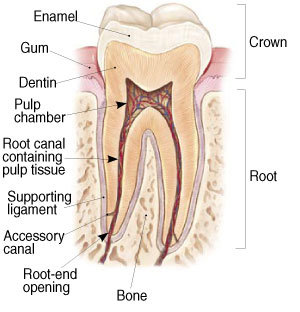 As you may be aware, your teeth play a vital role in maintaining long term good health. Unfortunately, as you age, cavities and other damage to your teeth may lead to tooth loss. Today, root canals are one of the most reliable methods for saving teeth that would have required extraction. Without a question, if you can arrange to visit a dentist in Shimla, it will be worth your while to ask about root canal treatment.
As you may be aware, your teeth play a vital role in maintaining long term good health. Unfortunately, as you age, cavities and other damage to your teeth may lead to tooth loss. Today, root canals are one of the most reliable methods for saving teeth that would have required extraction. Without a question, if you can arrange to visit a dentist in Shimla, it will be worth your while to ask about root canal treatment.In general, the process of root canal treatment first removes (as thoroughly as possible) bacteria, nerve tissue, the organic debris left over from the breakdown of nerve tissue, and bacterial toxins from within the inner aspects of a tooth (the area originally occupied by the tooth’s nerve tissue). Each of these items can produce tissue irritants that can cause your body to activate an inflammation reaction.
Subsequently, once this space has been cleansed the second half of root canal treatment involves filling in and sealing up the interior of the tooth. This aspect of the treatment is an attempt to minimize the possibility that bacteria will be able to recolonize the inner aspects of the tooth or that tissue fluids can seep inside the tooth, become stagnant, and subsequently break down. The seal also contains and encapsulates any debris that could not be fully removed during the cleaning aspect of the root canal treatment process so that it can’t leak out and trigger an inflammation reaction.
The problem with teeth and infections is that once a tooth’s nerve tissue has started to degenerate and bacteria have taken up residence in the tooth’s nerve area, there is no effective way for white blood cells to get at the bacteria to combat them. The dying nerve’s blood and lymphatic vessels used to transport white blood cells will have begun to degenerate too.
So the idea behind having root canal treatment is that it provides the bulk of the clean up work for your body. It removes bacteria and tissue irritants that are present inside the tooth, especially those in the locations where your body would have the most trouble combating them. As an end result, once root canal treatment has been completed it provides your body with an environment where its mechanisms are able to clear away any residual bacteria and tissue irritants that may still be present, thus allowing complete healing (resolution of the inflammation) to occur.
Symptoms that suggest that root canal therapy might be required:
* A tooth is currently causing you pain or else has a history of being painful.
* You have noticed the presence of gum tenderness and/or swelling in an area adjacent to a tooth
We’d acknowledge that root canal treatment has a reputation for being painful, but we’d be the last to agree that this reputation is deserved. It seems most likely to us that the majority of derogatory remarks you hear in regards to “having a root canal” almost certainly must have included in them references to the pain and discomfort that the person experienced leading up to receiving treatment.For the average person and the average case, root canal treatment is a nonevent and not any more uncomfortable than having a filling placed.
In just three visits to your dentist, you can have peace of mind knowing that you will be doing everything possible to preserve your natural teeth. This will be better in the long run than trying to cope with dentures that may break, slip, or fall out. In addition, you will also be pleased to know that root canals are far less damaging to the gums and bone tissue than any other tooth repair procedure. Therefore, if you have a condition that requires a root canal,consult your dentist soon.
2 comments:
well explained about root canal. You have some good tips here. Thanks for posting!
Dental experience is very painful. I had 8 root canal treatment it was a painful experience.
Post a Comment